Most of the high quality dry Grüner Veltliners and Rieslings come from Kremstal, Kamptal, and Wachau, three appellations located in Lower Austria — or Niederösterreich —, northwest of Vienna.
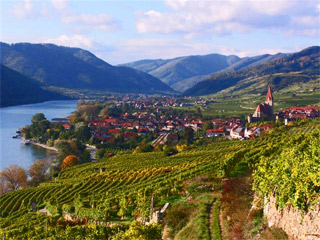
Terraced vineyards in the Wachau
Kremstal is named for the town of Krems, one of the oldest wine town in Austria. East of the Wachau and its steep terraced vineyards, Kremstal is where the Danube valley suddenly opens up into an open plain with gently rolling hills. The main wine producing towns are Göttweig, Furth, Gedersdorf, Rohrendorf, and Senftenberg.
The wines we tasted:
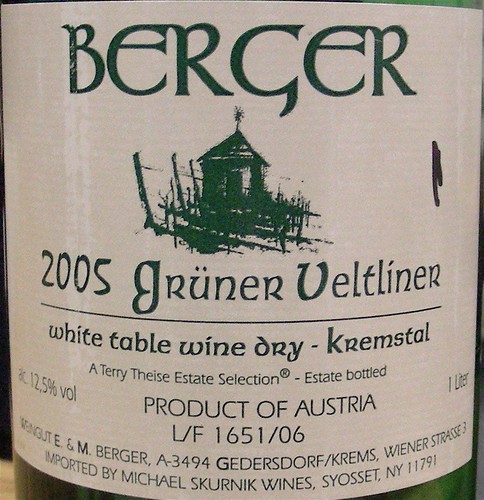 • 2005 Berger Grüner Veltliner: Weingut Berger is an estate of 18 hectares in the town of Gedersdorf, 7km east of Krems. Half of the production is dedicated to Grüner Veltliner but the winery also produces wines from Riesling, Welschriesling, and the red Zweigelt grape variety. My notes: this is their entry wine, bottled in a one liter sized bottle. Straw color with a greenish tinge, nicely aromatic on the nose, dry, medium-bodied on the palate with notes of mineral. A good value wine.
• 2005 Berger Grüner Veltliner: Weingut Berger is an estate of 18 hectares in the town of Gedersdorf, 7km east of Krems. Half of the production is dedicated to Grüner Veltliner but the winery also produces wines from Riesling, Welschriesling, and the red Zweigelt grape variety. My notes: this is their entry wine, bottled in a one liter sized bottle. Straw color with a greenish tinge, nicely aromatic on the nose, dry, medium-bodied on the palate with notes of mineral. A good value wine. • 2005 Salomon Undhof Grüner Veltliner Hochterrassen: located in Stein on the western border of Krems, Salomon Undhof is one of the most progressive and quality driven wineries in Austria. The family owns 20 hectares of vineyards, half planted with Grüner Veltliner, half with Riesling. My notes: straw color with a green tinge, subdued nose, more fruity than floral, mineral on the palate.
• 2005 Salomon Undhof Grüner Veltliner Hochterrassen: located in Stein on the western border of Krems, Salomon Undhof is one of the most progressive and quality driven wineries in Austria. The family owns 20 hectares of vineyards, half planted with Grüner Veltliner, half with Riesling. My notes: straw color with a green tinge, subdued nose, more fruity than floral, mineral on the palate.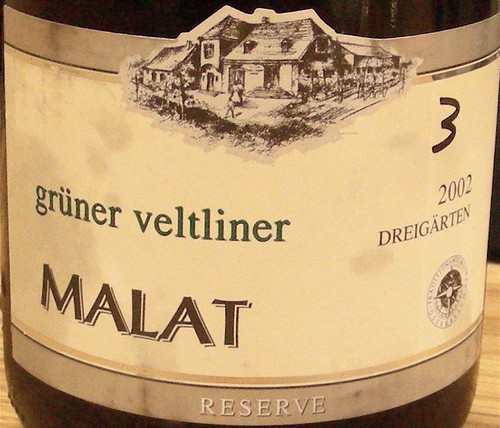 • 2002 Malat Dreigärten Grüner Veltliner Reserve: Weingut Malat is a 30 hectares estate located in the town of Palt. This wine comes from the best grapes from three different vineyards (drei gärten or three gardens). My notes: deep golden color, pear, peach, honey on the nose, almost a Riesling nose. On the palate, rich, smoky, crisp, with notes of grapefruit on the finish. Very distinctive.
• 2002 Malat Dreigärten Grüner Veltliner Reserve: Weingut Malat is a 30 hectares estate located in the town of Palt. This wine comes from the best grapes from three different vineyards (drei gärten or three gardens). My notes: deep golden color, pear, peach, honey on the nose, almost a Riesling nose. On the palate, rich, smoky, crisp, with notes of grapefruit on the finish. Very distinctive.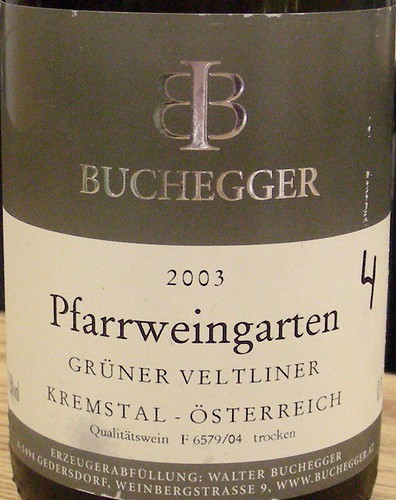 • 2003 Buchegger Pfarrweingarten Grüner Veltliner: Weingut Buchegger is a rising estate of 8 hectares in the town of Gedersdorf. My notes: deep golden color, perfume and talcum powder on the nose, grassy on the palate with a vivid acidity.
• 2003 Buchegger Pfarrweingarten Grüner Veltliner: Weingut Buchegger is a rising estate of 8 hectares in the town of Gedersdorf. My notes: deep golden color, perfume and talcum powder on the nose, grassy on the palate with a vivid acidity.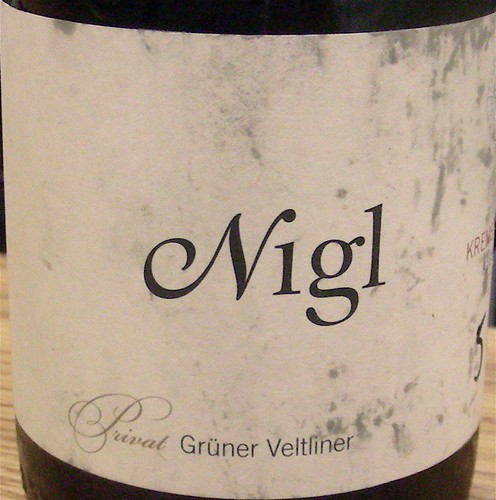 • 2004 Nigl Privat Grüner Veltliner: Weingut Nigl is an estate of 25 hectares in the Krems valley. My notes: light yellow color, intense, aromatic nose of fresh white peach, on the palate, rich and mineral with a long citrus finish. With the Malat, this was my favorite wine from the Kremstal.
• 2004 Nigl Privat Grüner Veltliner: Weingut Nigl is an estate of 25 hectares in the Krems valley. My notes: light yellow color, intense, aromatic nose of fresh white peach, on the palate, rich and mineral with a long citrus finish. With the Malat, this was my favorite wine from the Kremstal. • 2004 Türk Grüner Veltliner Vom Urgestein: Weingut Türk has 14 hectares in the town of Stratzing. This wine is a blend of two vineyards, the Ried Wachtberg and Alte Haide, with vines averaging 50 years of age. My notes: pale yellow color, citrusy nose, crisp palate, medium finish.
• 2004 Türk Grüner Veltliner Vom Urgestein: Weingut Türk has 14 hectares in the town of Stratzing. This wine is a blend of two vineyards, the Ried Wachtberg and Alte Haide, with vines averaging 50 years of age. My notes: pale yellow color, citrusy nose, crisp palate, medium finish.The Kamptal takes its name from the river Kamp, a 153km long river that flows into the Danube near Grafenwörth, east of Krems. Vineyards are spread around Langenlois, Austria's largest wine town. Soils are mostly loess, a fine-grained, densely compacted glacial dust, and loam, while higher vineyards are distinguished by weathered rock subsoils, which is ideal for Grüner Veltliner.
The wines we tasted:
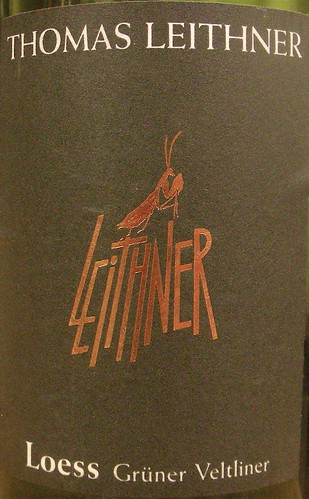 • 2004 Thomas Leithner Loess Grüner Veltliner: Weingut Thomas Leithner is an estate of 10 hectares in Langenlois with a well established reputation in Austria. It makes spicy Grüner Veltliners that are grown on loess rich vineyards. My notes: straw color with green tints, perfumed nose, fat mouthfeel with a vivid acidity on the palate, medium finish.
• 2004 Thomas Leithner Loess Grüner Veltliner: Weingut Thomas Leithner is an estate of 10 hectares in Langenlois with a well established reputation in Austria. It makes spicy Grüner Veltliners that are grown on loess rich vineyards. My notes: straw color with green tints, perfumed nose, fat mouthfeel with a vivid acidity on the palate, medium finish.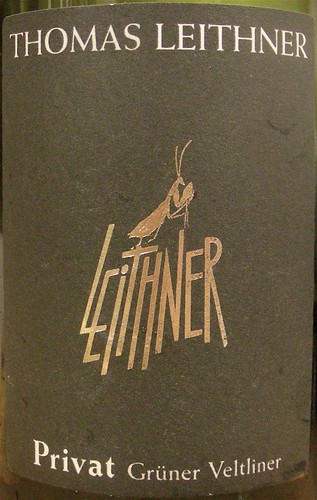 • 2002 Thomas Leithner Privat Grüner Veltliner: The Privat is a selection of the best grapes from the estate's best parcels. My notes: deep golden color, expressive and aromatic nose, rich aromas of tropical fruits, lengthy finish. Delicious!
• 2002 Thomas Leithner Privat Grüner Veltliner: The Privat is a selection of the best grapes from the estate's best parcels. My notes: deep golden color, expressive and aromatic nose, rich aromas of tropical fruits, lengthy finish. Delicious!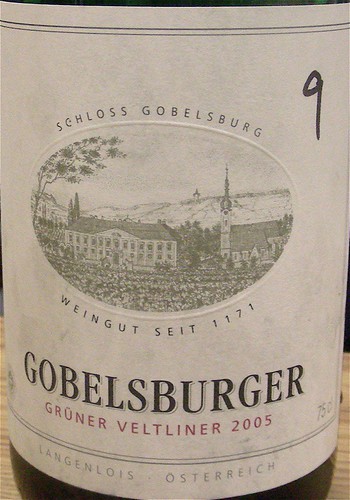 • 2005 Schloss Gobelsburg GobelsBurger Grüner Veltliner: founded in 1171, Weingut Schloss Gobelsburg is the region's oldest winery. Owned by a Cistercian monastery, it was also run by the monks themselves until 1995. Qui bon vin boit Dieu voit (who drinks good wine sees god) is the winery's motto. My notes: golden color, citrusy nose, a lot of acidity on the palate. By itself, it seems slightly unbalanced and may need some additional cellaring time but right now, it should be very good with shellfish.
• 2005 Schloss Gobelsburg GobelsBurger Grüner Veltliner: founded in 1171, Weingut Schloss Gobelsburg is the region's oldest winery. Owned by a Cistercian monastery, it was also run by the monks themselves until 1995. Qui bon vin boit Dieu voit (who drinks good wine sees god) is the winery's motto. My notes: golden color, citrusy nose, a lot of acidity on the palate. By itself, it seems slightly unbalanced and may need some additional cellaring time but right now, it should be very good with shellfish. • 2003 Schloss Gobelsburg Grüner Veltliner Renner: this wine is made from grapes growing on the hills, on soils dominated by gneiss. My notes: deep golden color, notes of mushroom and petrol on the nose, soft on the palate with mineral and smoked apple aromas, burnt sugar on the finish. Should be a great accompaniment to Peking Roast Duck.
• 2003 Schloss Gobelsburg Grüner Veltliner Renner: this wine is made from grapes growing on the hills, on soils dominated by gneiss. My notes: deep golden color, notes of mushroom and petrol on the nose, soft on the palate with mineral and smoked apple aromas, burnt sugar on the finish. Should be a great accompaniment to Peking Roast Duck.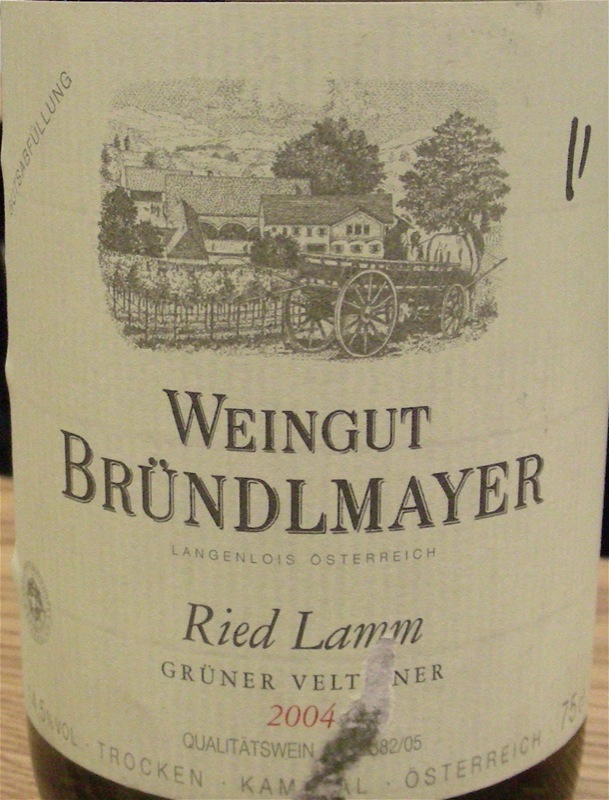 • 2004 Bründlmayer Grüner Veltliner Ried Lamm: with 60 hectares of vineyards scattered around the town of Langenlois, Weingut Bründlmayer is one of the most important Austrian estate. The Ried Lamm vineyard is a particularly warm spot on loess soils that is located between two large hilly vineyards, the Heiligenstein and Gaisberg. My notes: golden color, citrusy nose, well balanced on the palate, great mouthfeel, classy finish. One of my favorite wines from Kamptal with the Thomas Leithner Privat.
• 2004 Bründlmayer Grüner Veltliner Ried Lamm: with 60 hectares of vineyards scattered around the town of Langenlois, Weingut Bründlmayer is one of the most important Austrian estate. The Ried Lamm vineyard is a particularly warm spot on loess soils that is located between two large hilly vineyards, the Heiligenstein and Gaisberg. My notes: golden color, citrusy nose, well balanced on the palate, great mouthfeel, classy finish. One of my favorite wines from Kamptal with the Thomas Leithner Privat.The Wachau is a 30km/18 miles stretch of the Danube Valley between the towns of Melk and Krems, where the river is lined with steeply terraced vineyards. This region is one of Europe's most beautiful river landscapes and have been declared a World Heritage site. It is also considered Austria's finest wine region. The Wachau has a regional association called Vinea Wachau Nobilis Districtus that closely monitors the quality of the wines and has created three levels of classification: Steinfeder (less than 10.9% alcohol, light and racy), Federspiel (less than 11.9% alcohol, elegant and with body), and Smaragd (above 12% alcohol, highly ripe and powerful).
The wine we tasted:
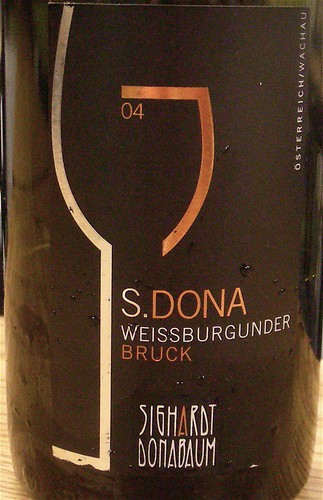 • 2004 Sighardt Donabaum S. Dona Weißburgunder Bruck: the Sighardt Donabaum estate is located in the village of Spitz, one of the region's main wine community. Just above the village there is a round low hill covered with terraced vineyards, which is called Tausendeimerberg, the 1000-Bucket's Mountain. It is said that in good years this hill could yield 1000 barrels of wine. My notes: a Pinot Blanc with a golden color, sweet white blossom aromas on the nose, and butterscotch flavors on the palate.
• 2004 Sighardt Donabaum S. Dona Weißburgunder Bruck: the Sighardt Donabaum estate is located in the village of Spitz, one of the region's main wine community. Just above the village there is a round low hill covered with terraced vineyards, which is called Tausendeimerberg, the 1000-Bucket's Mountain. It is said that in good years this hill could yield 1000 barrels of wine. My notes: a Pinot Blanc with a golden color, sweet white blossom aromas on the nose, and butterscotch flavors on the palate.Unfortunately, I could not attend the fourth session dedicated to the other regions of Austria, so coming next: the wines of Hungary
Related stories:
• Wines of Germany and Eastern Europe class: Rheingau, Mosel-Saar-Ruwer, and Mittelrhein
• Wines of Germany and Eastern Europe class: Nahe, Rheinhessen, and Pfalz
Technorati tags: wine food & drink
6 comments:
Sometimes I think how can you not fall in love with a wine that came from such beautiful places. Thank you for the wonderful TNs! I really should just print your blog up and go to my regular wine store to get every one of them.
I agree, now I want to go to Austria! The danube valley looks so beautiful!
Hello,
I loved your posting on the wines of Austria. I have spent a lot of time over there with my Austrian husband and I agree, the wines are excellent. I actually enjoy the red wines the most, like the Zweigelt or Blaufrankish. Stop by my blog and take a look at some of my posts.
Best Regards
Denise
http://www.WineFoodPairing.blogspot.com
Thanks for the link to your blog. I love your pairing with Fiery Habanero chips!
I only wish Kappy's near Boston had any of these Gruner Veltliners. The 2 they do have are good, but I love this style wine, and would like to try others. How much $ do they charge for these that you tried? To me, price counts. I can find you lots of great wine at $40/bottle. But find me a solid Pinot Noir for $15 and that will be something to rave about!
Here is a list of Gruner Veltliners from Blue Danube Wine to give you an idea of the prices.
Post a Comment